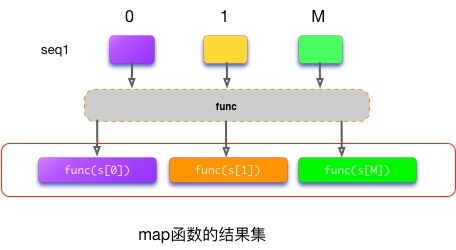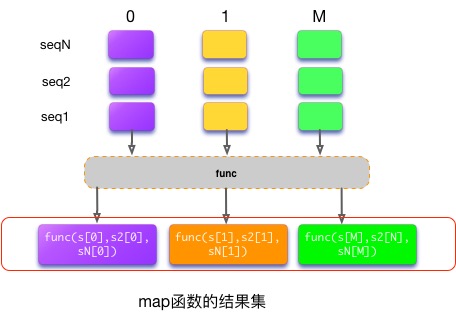【Python】map函数
一 简介
Python 内置了很多非常有用的函数 比如map() ,reduce(),filter(),还有lambda。熟练应用这些函数可以在写python程序的时候构建精简的代码。本文先来了解map函数。
二 使用
用法
map接收两个参数,第一个参数是函数名,第二个是一个或多个可迭代的序列,返回的是一个集合。运行时,map()将func作用于序列中的每一个元素,并将结果作为一个list返回。如果func为None,作用同zip()。
2.1 当seq 只有一个时,map函数返回将func函数作用于 seq每个元素并返回一个新的list集合,

比如需要将seq的元素乘以2 ,使用map可以写成
如果使用函数来做:
map作为高阶函数,能够把运算规则抽象化,显然map 更精简。
2.2 当有多个seq时,map可以并行的取每个seq对应的第M个元素 seqN[M],进行计算。

例子:
记得多个seq的元素个数必须一致 不然会报错
2.3 map在多进程中的应用。
该例子使用了multiprocessing.dummy的线程池Pool的方式,利用用map的特性来处理url集合。
参考文档
[1] [Python] Python中的一些特殊函数
Python 内置了很多非常有用的函数 比如map() ,reduce(),filter(),还有lambda。熟练应用这些函数可以在写python程序的时候构建精简的代码。本文先来了解map函数。
二 使用
用法
- map(func, seq1[, seq2,…])
2.1 当seq 只有一个时,map函数返回将func函数作用于 seq每个元素并返回一个新的list集合,

比如需要将seq的元素乘以2 ,使用map可以写成
-
In [4]: l=[1, 2, 3, 4, 5, 6, 7, 8, 9]
-
In [5]: map(lambda x:x*2 ,l)
- Out[5]: [2, 4, 6, 8, 10, 12, 14, 16, 18]
-
rest=[]
-
for i in l:
-
rest.append(i*2)
- print rest
2.2 当有多个seq时,map可以并行的取每个seq对应的第M个元素 seqN[M],进行计算。

例子:
-
In [9]: map(lambda x , y : x * y, [2,4,6],[3,2,1])
- Out[9]: [6, 8, 6]
-
In [1]: print map(lambda x , y : x ** y, [2,4,6],[3,2,1])
-
[8, 16, 6]
-
seq1=[2,4,6] ,seq2=[3,2] 元素个数不一致则报错。
-
In [3]: print map(lambda x , y : x ** y, [2,4,6],[3,2])
-
---------------------------------------------------------------------------
-
TypeError Traceback (most recent call last)
-
<ipython-input-3-d075c46afd0b> in <module>()
-
----> 1 print map(lambda x , y : x ** y, [2,4,6],[3,2])
-
<ipython-input-3-d075c46afd0b> in <lambda>(x, y)
-
----> 1 print map(lambda x , y : x ** y, [2,4,6],[3,2])
-
TypeError: unsupported operand type(s) for ** or pow(): 'int' and 'NoneType'
- In [4]:
-
#!/usr/bin/env python
-
# encoding: utf-8
-
"""
-
author: yangyi@youzan.com
-
time: 2017/7/16 上午10:42
-
func: 参考网络上的例子
-
"""
-
import urllib2
-
from multiprocessing.dummy import Pool as ThreadPool
-
urls = [
-
'http://www.python.org',
-
'http://www.python.org/about/',
-
'http://www.onlamp.com/pub/a/python/2003/04/17/metaclasses.html',
-
'http://www.python.org/doc/',
-
'http://www.python.org/download/',
-
'http://www.python.org/getit/',
-
'http://www.python.org/community/',
-
'https://wiki.python.org/moin/',
-
'http://planet.python.org/',
-
'https://wiki.python.org/moin/LocalUserGroups',
-
'http://www.python.org/psf/',
-
'http://docs.python.org/devguide/',
- 'http://www.python.org/community/awards/'
-
]
-
-
# Make the Pool of workers
-
pool = ThreadPool(4)
-
# Open the urls in their own threads
-
# and return the results
-
results = pool.map(urllib2.urlopen, urls)
-
#close the pool and wait for the work to finish
-
pool.close()
- pool.join()
参考文档
[1] [Python] Python中的一些特殊函数
正文到此结束
热门推荐
相关文章
Loading...











![[HBLOG]公众号](https://www.liuhaihua.cn/img/qrcode_gzh.jpg)

